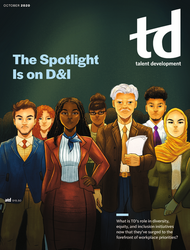TD Magazine Article
Six Indicators of Workplace Culture
Focus on these areas to enhance organizational culture.
Thu Oct 01 2020

Bookmark
Given current disruptions, improving workplace culture may seem like a far-off endeavor for talent development and HR professionals. But workplace culture matters to leading companies.
Emtrain's Workplace Culture Report 2020 defines workplace culture as "how we interact and treat each other in the workplace." In the report, researchers outline six key indicators of workplace culture and ways to address each area.
Organizations' norms and practices. These are "the spoken and unspoken rules that govern what behavior is and is not acceptable in the workplace." To build this area, consider role modeling from leaders, building new skills, and formal reinforcement.
In-group, out-group dynamics. These are feelings of us versus them, which 38 percent of employees identified as the greatest source of conflict. Such dynamics affect their perception of co-workers' or managers' empathy, respect, and trust. To solve, ensure managers receive regular feedback. Without manager accountability, employees may fear retaliation and won't speak up.
Power dynamics. This refers to "the way people use power in group and individual interactions." Nearly one-third of employees said power disparities cause the greatest level of conflicts at work, and 20 percent said people in authority often get away with bad behavior. The fix: Train management on power dynamics awareness, and make available a third-party mechanism for employees to submit concerns.
Pre-existing mindsets and behaviors. Employees' perceptions of the same conduct vary. That's why shaping common standards for acceptable behavior and building healthy approaches for addressing conflict is important. According to the report, "Teaching healthy conflict resolution skills could make the difference between keeping and losing top talent."
Unconscious bias. These are the "learned stereotypes, shaped by our life experiences, that influence our judgments about others." Organizations need to have concrete practices to counter the impact of unconscious bias. The report says companies should base decisions on hiring, performance, and conflict resolution on well-defined, objective criteria.
Social intelligence. This is "the ability to recognize, and skill to negotiate, the social dynamics of the workplace." Such practices as asking open-ended questions to understand others' point of view, apologizing when things go awry, and calmly receiving feedback can increase employees' social intelligence.
Those six factors are integral to strong workplace culture, which can be a cornerstone of a company's success. To strengthen workplace culture, organizations should consider how they can develop employees in those critical areas.

More from ATD
